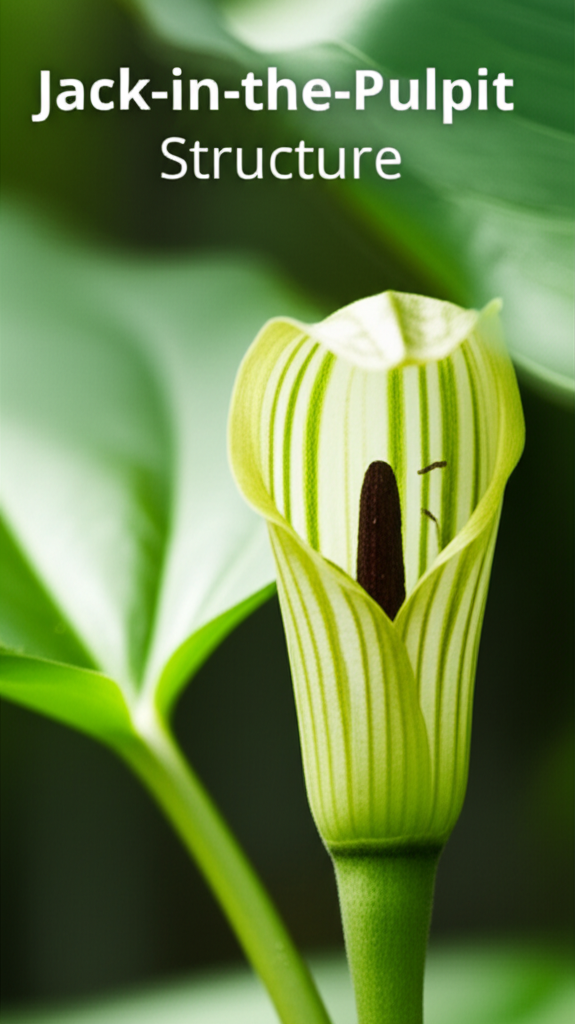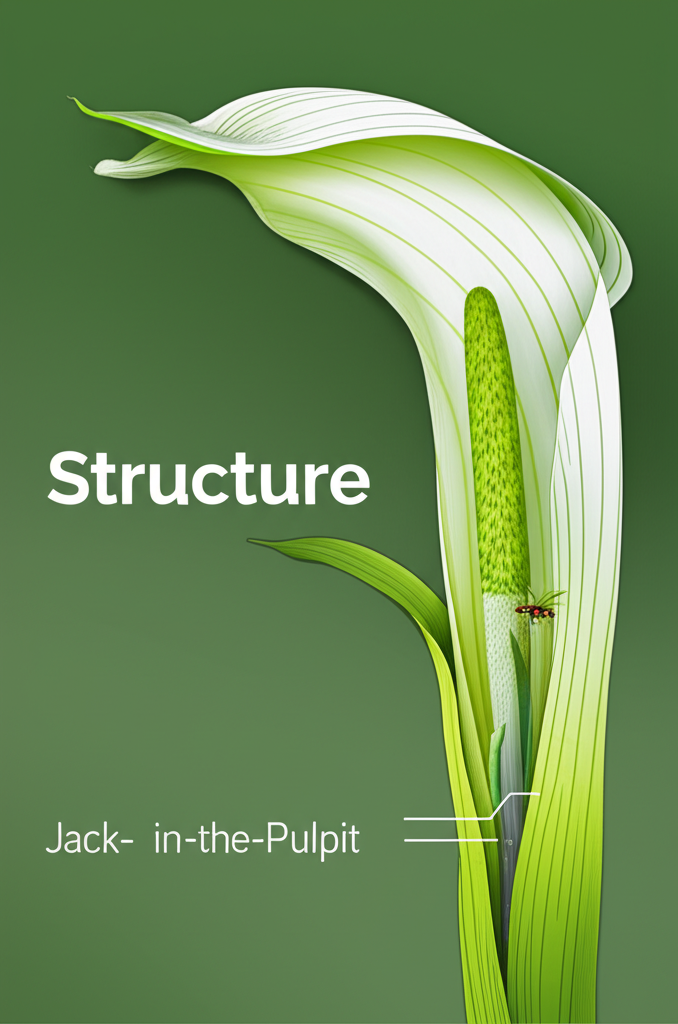The Fascinating World of Jack-in-the-Pulpit: A Botanical Marvel
The Jack-in-the-Pulpit, scientifically known as Arisaema triphyllum, is a native woodland wildflower that captivates botanists and nature enthusiasts alike with its unique and intricate floral structure. Often found gracing the shaded floors of deciduous forests across eastern North America, this perennial herb is a masterclass in evolutionary adaptation. Its common name, derived from the distinctive hooded spathe enclosing the spadix, paints a vivid picture of its unusual appearance, often likened to a preacher standing in a pulpit. However, beneath this whimsical facade lies a complex reproductive strategy that ensures the survival of the species. This guide delves deep into the flower’s anatomy, its fascinating pollination mechanisms, and the ecological significance of this woodland gem.
Understanding the Unique Floral Structure

The Jack-in-the-Pulpit’s reproductive parts are not housed in what we typically recognize as a flower. Instead, the plant produces a reproductive structure called an inflorescence, composed of a spadix and a spathe.
The Spadix: The “Jack”
The spadix is the central, finger-like structure, typically greenish or purplish, that emerges from the spathe. It is the primary site of the plant’s reproductive organs.
- Male Flowers: Located at the top of the spadix, these are rudimentary and typically consist of just stamens.
- Female Flowers: Found lower down on the spadix, these possess pistils.
- Sterile Appendages: In many species, the spadix is topped with a sterile, club-shaped appendage. This appendage is believed to play a role in attracting pollinators or in the plant’s unique thermogenic properties.
The Spathe: The “Pulpit”
The spathe is the large, hooded leaf-like structure that enfolds the spadix. It is often green with purplish stripes or entirely purplish. The spathe’s primary functions are to protect the developing reproductive organs and to act as a landing platform and guide for potential pollinators.
- Shape and Size: The spathe typically curves inward, creating a hooded or helmet-like enclosure. Its size can vary, but it is generally substantial enough to completely cover the spadix, except for a small opening at the front.
- Coloration: The distinctive purplish veining within the green spathe is thought to be a visual attractant for insects.
The Irid: The Hidden Interior
The interior of the spathe, surrounding the spadix, is often lined with downward-pointing hairs called “irids.” These hairs are a crucial component of the plant’s pollination strategy.
- Function of Irid Hairs: The irid hairs are essentially a one-way trap. They allow small insects to crawl into the spathe but make it difficult for them to climb back out. This ensures that pollinators spend sufficient time on the spadix, facilitating pollen transfer.
- Exit Strategy: Once the female flowers have been pollinated and the fruit begins to develop, the irid hairs wither, allowing the pollinated insects to escape.
The Remarkable Pollination Process
The Jack-in-the-Pulpit employs a sophisticated and somewhat predatory pollination mechanism, relying on small insects, primarily gnats and flies, to carry pollen.
Attracting Pollinators
The plant utilizes a multi-pronged approach to lure its intended pollinators:
- Visual Cues: The striking coloration and pattern of the spathe, particularly the purplish veins, serve as visual attractants.
- Olfactory Signals: While not as strong as some other flowers, the Jack-in-the-Pulpit emits a faint, sweet scent, especially during peak flowering.
- Thermogenesis: Arisaema triphyllum is one of the few plants known to exhibit thermogenesis, meaning it can generate its own heat. The spadix can warm up to a few degrees Celsius above the ambient temperature. This heat may further attract insects seeking warmth, especially on cooler spring days.
The Insect Trap Mechanism
Once an insect is lured into the spathe, the “trap” is sprung:
- Entry: Drawn by scent and warmth, small insects enter the opening at the front of the spathe.
- The Descent: The spadix, often slick and moist, guides the insects downward into the enclosed chamber.
- The Irid Barrier: Upon attempting to climb back out, the insects encounter the dense mat of downward-pointing irid hairs. These hairs prevent their escape, effectively trapping them within the spathe.
- Pollen Collection: While trapped, the insects crawl over the spadix, encountering the male and female flowers. Pollen from the male flowers adheres to their bodies. If they have visited another Jack-in-the-Pulpit previously, they may also deposit pollen from that plant onto the receptive stigmas of the female flowers.
- The Escape: After a period (which can be a day or more), the female flowers are pollinated, and the irid hairs begin to wither. This allows the trapped insects, now laden with pollen, to finally escape. They then fly off to visit another Jack-in-the-Pulpit, continuing the pollination cycle.
Pollinator Specificity and Efficiency
The Jack-in-the-Pulpit is not indiscriminate in its choice of pollinators. The size of the floral chamber and the spacing of the irid hairs are precisely tuned to trap small insects like midges and gnats. Larger insects or beetles are generally too big to be effectively trapped. This specificity ensures that the pollen is transferred efficiently between receptive flowers of the same species.
Key Facts and Comparison
The Jack-in-the-Pulpit presents a unique botanical case study. Here’s a quick overview of its key characteristics and how it differs from more conventional flowering plants.
| Feature | Jack-in-the-Pulpit (Arisaema triphyllum) | Typical Flower (e.g., Rose) |
|---|---|---|
| Reproductive Structure | Spadix and Spathe (modified leaves/inflorescence) | Petals, Sepals, Stamens, Pistil |
| “Flower” Appearance | Hooded spathe enclosing a central spadix | Open, radially symmetrical petals |
| Pollination Mechanism | Insect trap with downward-pointing hairs (irids); thermogenesis | Attraction via petals, scent, nectar; wind or animal transfer |
| Pollen Transfer | Deliberate trapping and release of small insects | Passive transfer by wind, or direct contact with pollinators |
| Habitat | Shaded, moist woodlands; North America | Varies greatly by species; often open, sunny areas |
| Toxicity | Contains calcium oxalate crystals (irritant); toxic if eaten raw | Varies; many are non-toxic, some have mild irritants |
Life Cycle and Reproduction
The life cycle of the Jack-in-the-Pulpit is intrinsically linked to its unique reproductive strategy and its woodland environment.
Sexual Dimorphism and Gender Changes
A fascinating aspect of Arisaema triphyllum is its ability to change sex. Individual plants often start as males and, as they grow larger and accumulate more resources, can transition to becoming female in subsequent years. This ensures that larger, more established plants produce seeds, maximizing reproductive success. The plant can also revert from female back to male if conditions are unfavorable or if it shrinks in size.
Fruiting and Seed Dispersal
After successful pollination, the spathe wilts, and the spadix elongates, bearing a cluster of bright red to reddish-orange berries. These berries are attractive to birds and small mammals, which consume them and disperse the seeds through their droppings. This is the primary method of seed dispersal for the Jack-in-the-Pulpit.
Germination and Seedling Growth
Jack-in-the-Pulpit seeds require a period of cold stratification to germinate. Once germinated, the seedlings are slow-growing, often taking several years to reach reproductive maturity and produce their first flowers.
Ecological Significance and Conservation
The Jack-in-the-Pulpit plays a vital role in its native ecosystem. Its unique pollination strategy, its role as a food source for wildlife (in its berry stage), and its preference for specific woodland conditions make it an indicator species for healthy forest habitats.
- Habitat Indicator: The presence of Jack-in-the-Pulpit often signifies a healthy, undisturbed deciduous forest with adequate shade, moisture, and rich soil.
- Food Source: The berries are a food source for various birds and small mammals.
- Pollinator Support: While it traps its pollinators, it also provides them with a relatively safe, warm, and scent-filled environment for a period, potentially benefiting their survival.
Common Pests and Diseases
Like many plants, the Jack-in-the-Pulpit can be susceptible to certain pests and diseases, although it is generally quite resilient in its natural habitat.
- Slugs and Snails: These gastropods can feed on the leaves and developing spathe, causing aesthetic damage.
- Fungal Diseases: Powdery mildew and other fungal infections can sometimes affect the foliage, especially in humid conditions.
- Herbivores: Deer may occasionally browse on the foliage, although the presence of calcium oxalate crystals makes it less palatable than many other plants.
Cultivation and Care
For those wishing to cultivate this unique plant in their own gardens, understanding its specific needs is crucial.
Optimal Growing Conditions
- Light: Partial to full shade. Avoid direct sunlight, which can scorch the leaves.
- Soil: Moist, well-drained, humus-rich soil. A woodland garden setting is ideal.
- Water: Keep the soil consistently moist, especially during the growing season.
- Mulch:** Mulching around the base of the plant helps retain moisture and suppress weeds.
Propagation
Jack-in-the-Pulpit can be propagated by division of rhizomes in early spring or fall, or by seed. Seed propagation is slower, requiring patience and appropriate stratification.
Steps for Pollination Observation and Study
Observing the pollination process of the Jack-in-the-Pulpit can be a rewarding experience for any budding botanist or nature enthusiast. Here’s a guide to help you understand and potentially witness this fascinating phenomenon.
| Step | Action | Notes |
|---|---|---|
| 1 | Locate Mature Plants | Look for plants in bloom during spring, typically April to June, in shady woodland areas. |
| 2 | Identify Blooming Flowers | Distinguish between male and female plants. Male plants have a single spathe and spadix. Female plants are larger and may have multiple spathes/spadixes on the same stem, or can be distinguished by their berry production later in the season. (Note: Gender determination can be complex and plants can change sex). |
| 3 | Observe Insect Activity | Look for small flies, gnats, and midges hovering around or entering the spathe. Patience is key. |
| 4 | Monitor Spathe Entrance | Observe the opening of the spathe. You might see insects disappear inside. |
| 5 | Note Irid Hair Presence | If you can carefully (and ethically) access a spent spathe after fruiting, observe the remaining irid hairs. |
| 6 | Observe Fruiting Stage | In late summer and fall, look for the vibrant red berries, indicating successful pollination. |
Pros and Cons of the Jack-in-the-Pulpit’s Pollination Strategy
The unique pollination method of the Jack-in-the-Pulpit has evolved to suit its specific ecological niche.
| Pros | Cons |
|---|---|
| High Pollen Transfer Efficiency: Trapping insects ensures they deposit pollen on multiple flowers before escaping. | Reliance on Specific Pollinators: Vulnerable to declines in populations of small flies and gnats. |
| Reduced Pollinator Waste: Only small insects are trapped, minimizing energy expenditure on attracting a wide range of visitors. | Potential for Predation: While the trap is effective, the plant is not entirely immune to damage from larger herbivores. |
| Protection of Reproductive Organs: The spathe provides shelter and protection for the delicate flowers. | Limited Range of Action: The trapped insects may not travel far, potentially leading to localized gene flow. |
| Thermogenesis Attracts Pollinators: The added warmth can be a significant draw on cooler days. | Toxicity to Humans and Animals: The calcium oxalate crystals make it unpalatable and potentially harmful if consumed raw. |
| Efficient Seed Set: The precise trapping mechanism often leads to a high success rate in fertilization and berry production. | Slow Establishment: The reliance on seed dispersal and slow seedling growth can limit rapid population expansion. |
Conclusion
The Jack-in-the-Pulpit stands as a testament to the ingenuity and diversity of the plant kingdom. Its peculiar yet effective pollination strategy, its fascinating gender-changing ability, and its essential role in the woodland ecosystem highlight the intricate web of life. By understanding the structure and pollination guide of this remarkable wildflower, we gain a deeper appreciation for the delicate balance of nature and the evolutionary marvels that unfold in our own backyards. Whether you encounter it on a forest hike or choose to cultivate it in your garden, the Jack-in-the-Pulpit offers a compelling glimpse into the secrets of botanical survival and adaptation.


